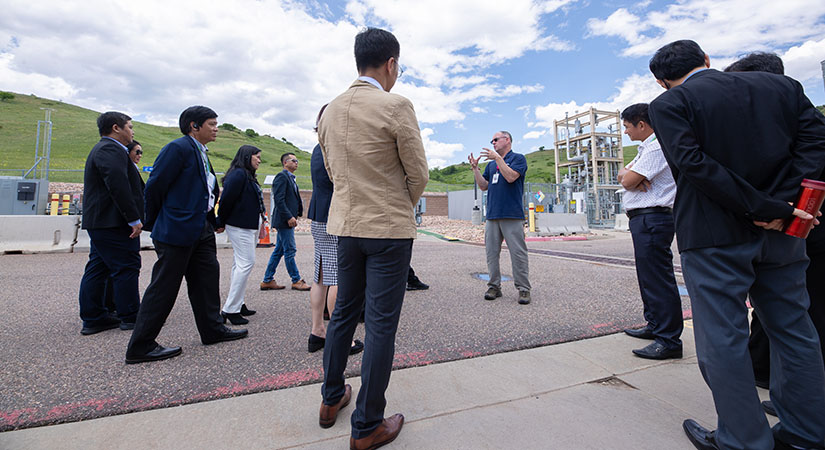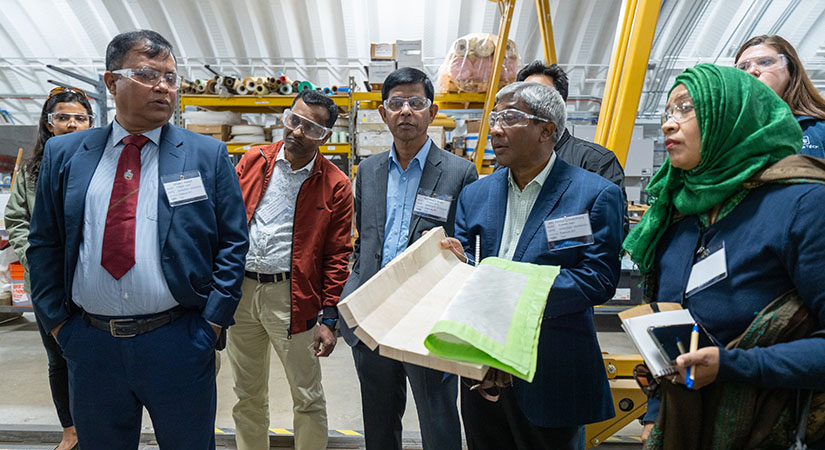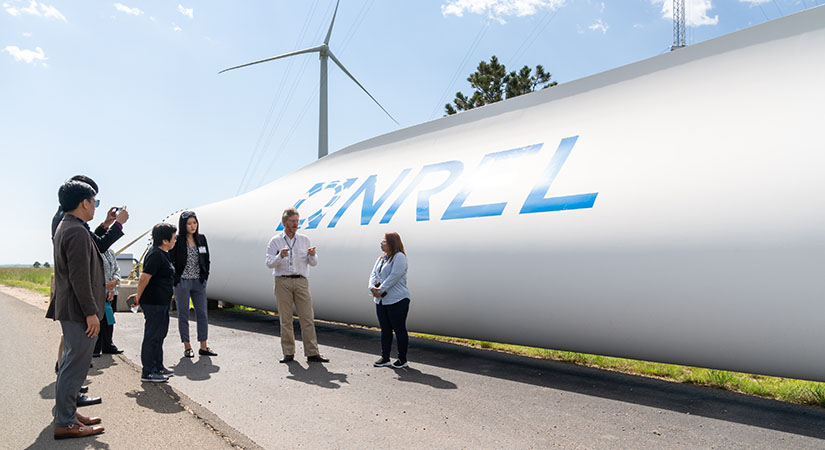The USAID and NREL Quarterly Newsletter
July 2023 Edition
In this edition, learn about support for Ukraine's energy system resilience, floating solar photovoltaic deployment in Asia, and explore events and visits from this quarter.
Subscribe to receive this newsletter via email.
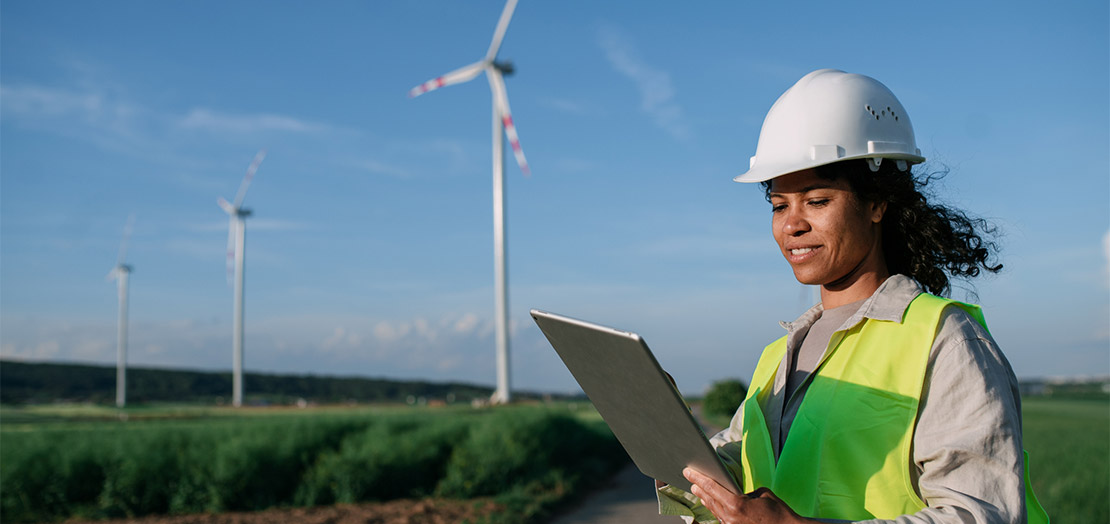
Contents
Empowering Women and Girls to Achieve Just Energy Transitions
Welcome to the 2023 Women in Power System Transformation Interns
Floating Solar Photovoltaic Deployment in Southeast Asia to Support Regional Energy Needs
USAID-NREL Partnership Team Makes a Splash at the Asia Clean Energy Forum
NREL Welcomes Visitors From Around the World to Its World-Class Research Facilities
Empowering Women and Girls to Achieve Just Energy Transitions
The USAID-NREL Partnership is at the center of creating a low-carbon and climate-resilient global economy that benefits all people. With "Just Energy Transitions" as one of the USAID-NREL Partnership's cross-cutting strategic pillars, we ensure that NREL's world class technical expertise supports global efforts to scale up advanced clean energy systems, decarbonize economies, and combat climate change in socially inclusive ways.
Gender equity, a key element of just energy transitions, is described in the USAID 2023 Gender Equality and Women's Empowerment Policy as the vision of “a prosperous and peaceful world in which women and girls, men and boys, and gender diverse individuals enjoy equal rights and agency; have equitable access to quality education and health care; accumulate and control their own assets; exercise their own voice; and live free from restrictive gender norms and violence.”
Advancing the status of women and girls is not only a matter of human rights, justice, and fairness—it also reduces poverty, promotes sustainable economic growth, increases access to education, improves health outcomes, advances political stability, and fosters democracy. Women are key stakeholders in the clean energy transition and must be included in the global movement toward transformative projects, programs, and policies that will accelerate universal energy access and address climate change equitably. This is something that we recognize and have formalized with the recently launched USAID-NREL Action Plan for Gender Integration.
The USAID-NREL Action Plan for Gender Integration assists NREL researchers and other practitioners working across the USAID portfolio in addressing critical gender gaps in particular country contexts and directing resources where they are most needed to empower women. Already, the USAID-NREL Partnership is successfully integrating gender equality throughout our work in very tangible ways, such as through our Women in Power System Transformation (PST) program, which just launched its second round of summer internships in June 2023.
"Being the first woman fellow in [the California Independent System Operator] CAISO from [the national electricity utility] PLN Indonesia made me realize that I can do what I thought was impossible.” These are powerful words from one of our Women in PST participants that represent the type of impact we are aiming to scale up across all our work.
We are leveraging USAID and NREL's thought leadership, unique capabilities, and convening power to increase gender integration in clean energy initiatives across the globe. Consistent gender approaches across the USAID and NREL portfolio will have significant impact on the gender equality and social inclusion outcomes while strengthening the effectiveness of our programs.
If you are interested in learning how you can incorporate gender equity considerations into your project, please reach out to USAID.NREL@nrel.gov.
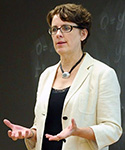
Best,
Ellen Morris, Ph.D.
USAID-NREL Partnership Lead Gender Strategist
National Renewable Energy Laboratory
What's New
NREL Researchers Are Providing Tools and Technical Support To Help Ukraine Realize a Resilient, Decentralized, Renewable Energy Grid
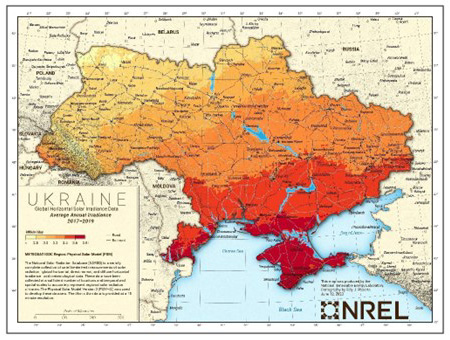
Ukraine 4-km solar resource data, available on the RE Data Explorer platform. Illustration by Billy Roberts, NREL.
Ukraine is maintaining its power and heating systems while their grid is constantly targeted by missiles and other types of attacks. Resilience—for the grid, for the people operating the grid, for Ukraine—is essential for the country now and as they look to the future. In partnership with USAID, NREL is offering support that will enable Ukraine to increase their energy independence and resilience by integrating more renewables into their national energy mix.
NREL recently published solar resource data for all of Ukraine. This data—showing the average amount of sunlight received over the course of the year in 4-square-kilometer resolution—serves as the foundation for many other NREL-developed software platforms that help size and design solar photovoltaic (PV) systems. The most popular of these, PVWatts®, has been translated into the Ukrainian language, to enable any Ukrainian to see how much energy solar PV panels on their building could generate.
For now, the underlying solar resource data comes from just 3 years of satellite observations (2017–2019), but the NREL solar resource team will expand this to 20 years of data soon. NREL teams will also be adding other renewable energy resource data for Ukraine to the RE Data Explorer platform that allows people around the world to assess their local renewable energy potential and inform renewable energy development decisions. Critically, wind resource data is anticipated to be added for Ukraine by early 2024.
Learn more about the extent of NREL's support to Ukraine's energy sector: Ukraine Fights To Build More Resilient, Renewable Energy System in Midst of War.
Watch the webinar tutorial for using PVWatts for Ukraine:
PVWatts and Solar Resource Data for Ukraine (English)
PVWatts Вступ та використання (Ukrainian)
Welcome to the 2023 Women in Power System Transformation Interns
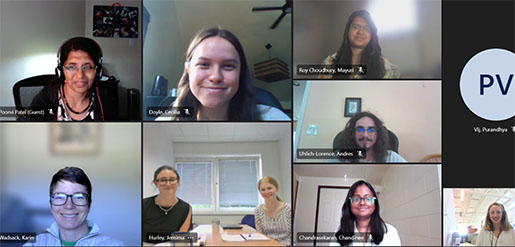
USAID and NREL are excited to welcome the newest cohort of Women in Power System Transformation (PST) interns. From June to August 2023, NREL and the Electric Power Research Institute (EPRI) will welcome eight undergraduate and graduate student interns for research, technical training, mentorship, and networking opportunities.
Women in PST is a joint initiative from the Global Power System Transformation Consortium and the USAID-NREL Partnership to expand leadership and technical training opportunities for women and other underrepresented groups in the power sector.
The Women in PST interns will support cutting-edge technical research on topics such as electromagnetic transient modeling and grid-forming inverters. They will also visit NREL's facilities for hands-on exploration of innovative renewable energy technologies and collaboration with researchers and practitioners at the forefront of clean energy integration.
Their technical experience will be supplemented with networking opportunities such as technology symposiums, a “coffee chat” series where interns and experts can informally share and ask questions, and other events for the interns to engage with industry professionals and deepen their understanding of power system operation.
The interns will also participate in the Self-Empowerment and Equity for Change (SEE Change) Initiative offered by Johns Hopkins University. The SEE Change seminar uses neuroscience and positive psychology to highlight personal agency in overcoming workplace challenges and achieving personal and professional goals.
Please join us in welcoming the Summer 2023 cohort of Women in PST interns:
- Celia Doyle, Johns Hopkins University, EPRI
- Jemima Hurley, University College Dublin, EPRI
- Alison Kelley, University College Dublin, EPRI
- Chandinee Chandrasekaran, University of Colorado Boulder, EPRI
- Andreas Uhrich-Lorence, Missouri University of Science and Technology, EPRI (waiting on bio)
- Mayuri Roy Choudhury, Arizona State University, EPRI (waiting on bio)
- Mahitha Pillodi, University of Wisconsin–Madison, NREL
- Selma Bennai, National Engineering School of Tunis, Tunisia, NREL.
Learn more about Women in PST program and its resources.
Floating Solar Photovoltaic Deployment in Southeast Asia to Support Regional Energy Needs
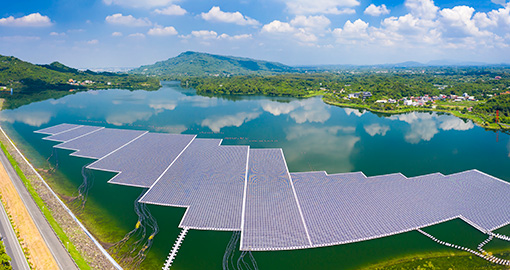
Creative solutions are needed to solve complex problems. When it comes to renewable energy deployment, floating solar photovoltaic (FPV) systems are one of those creative solutions. FPV systems are made up of the same solar panels mounted on land, but are instead mounted to floating structures as stand-alone or hybridized systems. Especially in Southeast Asia, a region with growing energy demand and abundant hydropower resources vulnerable to droughts or floods, deploying FPV systems can help meet decarbonization and energy security goals.
A new report released through USAID and NREL's Advanced Energy Partnership for Asia program details the findings of a geospatial assessment to estimate the technical potential for FPV installations on reservoirs and natural bodies of water within the Association of Southeast Asian Nations. Policymakers and developers in the region can use the report's findings to optimize siting FPV systems (based on area, MW of installation, and GWh generated per year), as well as investigate how FPV could assist in meeting regional energy demand and spur investment.
This analysis also informed the development of the first FPV data set available through the RE Data Explorer geospatial analysis tool. Stakeholders throughout Southeast Asia can use RE Data Explorer to assess site feasibility for FPV projects at no cost.
Learn more about the development of the FPV data set and what it means for Southeast Asia's energy portfolio in this NREL news article: Floating Photovoltaics Emerge as a Promising Solution for Southeast Asia's Clean Energy Future.
Visit the RE Data Explorer to download the FPV data set for Southeast Asia.
USAID-NREL Partnership Team Makes a Splash at the Asia Clean Energy Forum
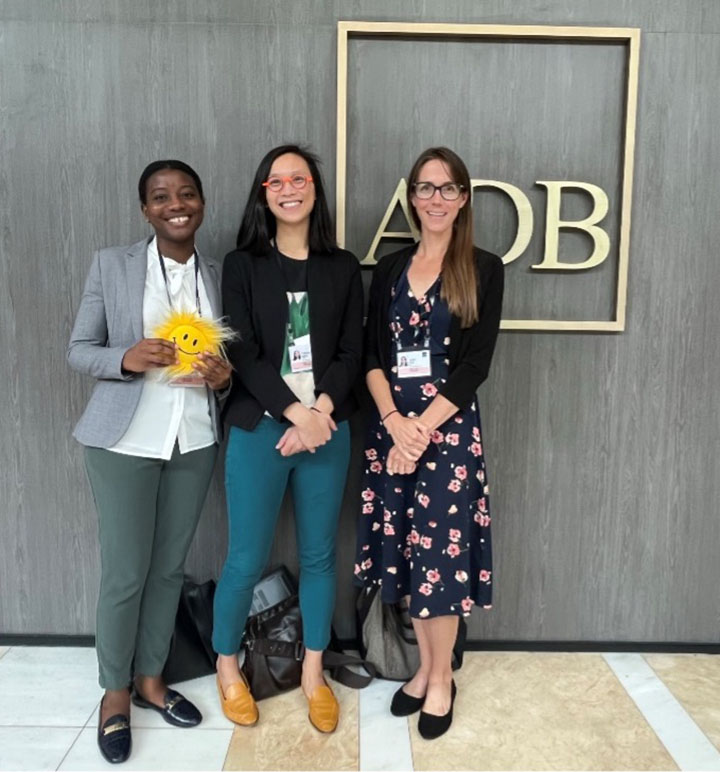
From left to right, Sika Gadzanku, Derina Man, and Sadie Cox traveled to the Asia Clean Energy Forum. Photo by Prathibha Juturu, USAID
In June, three NREL staff members, Sadie Cox, Derina Man, and Sika Gadzanku, traveled to Manila, Philippines, for the Asia Clean Energy Forum (ACEF). This conference, organized by USAID, the Asian Development Bank, and the Korea Energy Agency, brings together clean energy practitioners from across Asia and the Pacific to discuss prosperous, inclusive, resilient, and sustainable transitions across the region. NREL researcher Fei Ding also joined a panel virtually.
Sadie Cox, NREL's Director of International Strategic Partnerships, delivered a keynote address during the opening plenary on how NREL's research focuses not only on transforming energy systems, but also on addressing societal and systemic challenges. Derina Man, project lead for the Advanced Energy Partnership in Asia, copresented with USAID during a deep-dive session on the role that fundamental science and research from the national laboratories can play to accelerate private sector innovation and development. Sadie and Derina also presented during a session on transmission and distribution challenges, which featured a virtual presentation by researcher Fei Ding on grid hardening and modernization.
As part of the emerging FPV research, subject matter expert Sika Gadzanku spoke in two sessions on the role of FPV as an emerging trend in Asia and the Pacific. In another session, she also discussed digital technology as a driver of decarbonization by highlighting RE Data Explorer's unique capabilities for resource visualization.
As renewable energy expands throughout Asia, conferences like ACEF provide vital forums for bringing together government entities, the private sector, and technical institutions to collaborate and learn from one another.
Visit the ACEF website to view recordings of each of the sessions.
Read about presentations on the FPV work in this program news story.
NREL Welcomes Visitors From Around the World to Its World-Class Research Facilities
Through support from USAID, NREL hosted several groups of international visitors at NREL’s world-class research facilities in May and June 2023. Country partners and USAID representatives from Vietnam, the Philippines, and Bangladesh explored NREL’s cutting-edge technologies and collaborated with researchers on how to achieve their clean energy goals.
NREL’s campuses provide valuable resources for visitors to explore top-of-the-line energy tools and solutions. All three groups visited the South Table Mountain Campus in Golden, Colorado, which is host to several research facilities, including the Energy Systems Integration Facility. This facility offers visitors a chance to tour hydrogen fueling infrastructure, NREL’s Kestrel supercomputer, and world-class technology testing laboratories.
The visitors also toured NREL’s Flatirons campus in Boulder, Colorado. The Flatirons campus is home to the National Wind Technology Center, a hub for state-of-the-art wind energy research, technology, development, and experimentation. The visiting groups had the opportunity to learn from NREL wind energy researchers and view turbine technologies up close.
Both facilities, among many others on NREL's campuses, are home to world-class modeling and testing resources for grid integration and innovative technology. Additionally, the lab's leading research staff are excellent resources for collaboration and capacity building.
USAID missions and country partners interested in visiting NREL or exploring joint research and testing opportunities at the lab should speak with their USAID-NREL Partnership project lead or contact USAID-NREL Partnership staff.
Read about the USAID Bangladesh visit to NREL.
USAID and Partner Labs Launch Second Phase of the South Asia Group for Energy
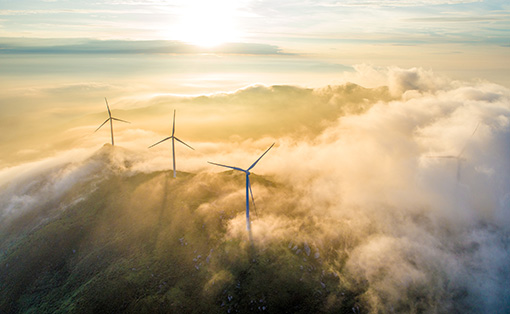
In early May 2023, in New Delhi, India, USAID and three U.S. Department of Energy national laboratories (NREL, Pacific Northwest National Laboratory, and Lawrence Berkeley National Laboratory) formally launched the second phase of work under the South Asia Group for Energy program, or SAGE.
Through SAGE, stakeholders across South Asia can access best-in-class energy expertise to support long-term planning and receive consultation on complex energy challenges. The launch event consisted of a round table with expert speakers from Government of India ministries, national lab experts, and South Asian utilities. These participants discussed SAGE’s activities and analysis relating to pathways for sustainable growth, just coal transitions, and more.
At the launch, SAGE also presented a new report, commissioned by India’s Ministry of New and Renewable Energy, that reviews the existing framework for variable renewable energy forecasting in India and presents potential opportunities for improvement that can support large-scale renewable energy integration.
Explore the full report: Institutional Framework of Renewable Energy Forecasting in India.
Mexico City Efficient Building Challenge Achieves Energy Savings and Emissions Reductions
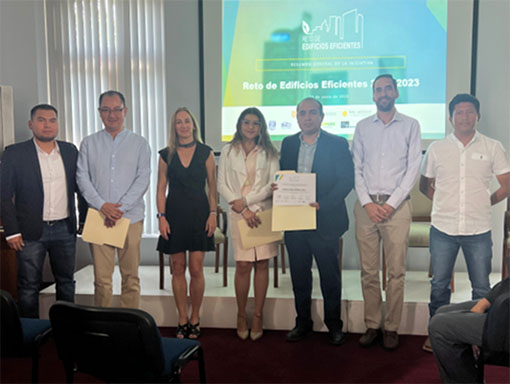
Participants gather at the closing event of the 2022 Mexico City Efficient Building Challenge. Photo by Lawrence Berkeley National Laboratory
Led by the World Resources Institute in Mexico and the Mexico City Secretariat of the Environment, the 2022 Mexico City Efficient Building Challenge welcomed private companies from across Mexico to participate in efforts to cut energy use and emissions by 10% annually and avoid 825 tons of carbon dioxide equivalent (CO2e) emissions each year. The companies that engaged in this initiative, supported by USAID Mexico and Lawrence Berkeley National Laboratory (LBNL), reduced energy usage and greenhouse gas emissions by 6% in only 5 months.
The technical assistance delivered by LBNL and USAID/Mexico consisted of the use of the Building Efficiency Targeting Tool for Energy Retrofits (BETTER) toolkit to help building managers and operators assess energy usage in private buildings and recommend low- or no-cost energy efficiency measures to result in economic and environmental benefits. Representatives of the private companies that participated in the challenge recognized the impact of BETTER and committed to continuing implementation of energy efficiency interventions.
During the closing event of the Challenge, LBNL launched the BETTER | Mexico toolkit, which adds a building energy database specific to Mexico, customized building electricity statistics, and fossil energy consumption statistics to deliver precise benchmarking and net-zero retrofit analysis of buildings in Mexico. The customized toolkit is accessible in English and Spanish.
The Challenge outcomes and the launching of the BETTER I Mexico toolkit contribute to raising awareness among Mexico’s private sector about the need to improve energy performance in buildings and will generate more opportunities to leverage BETTER to support benchmarking efforts.
Watch this video to hear testimonials by Challenge participants in Spanish.
USAID Mexico and Lawrence Berkeley National Laboratory Advance Partnerships With the Real Estate Industry to Deploy Technical Assistance in the Buildings Sector

As part of ongoing engagement with the construction industry in Mexico to advance energy efficiency measures, LBNL and Fibra Uno (FUNO), with support from USAID Mexico, expanded the use of the BETTER | Mexico toolkit to analyze FUNO’s extensive building portfolio.
FUNO is Mexico and Latin America’s largest real estate investment trust, with a portfolio accounting for roughly 30% of all properties belonging to real estate investment trusts in the country.
FUNO will be featured in net-zero and energy efficiency case studies under the partnership with USAID Mexico and LBNL. These expanded efforts follow the deployment of the BETTER toolkit to accelerate energy efficiency and net-zero energy retrofits for nearly 100 of FUNO properties across Mexico. The enhanced collaboration aligns with FUNO’s sustainability goals.
The scaled-up collaboration with USAID Mexico and LBNL has the potential for a 10% reduction in FUNO’s energy consumption, which will avoid emission of 695,000 metric tons of carbon dioxide equivalent. The partnership demonstrates an approach for decarbonizing real estate investment portfolios at speed, scale, and low cost for 2,000 real estate investment trust properties in Mexico.
Increasing collaboration with the construction industry in Mexico is central in USAID Mexico and LBNL efforts to scale up energy efficiency and net-zero interventions in the building sector through the BETTER | Mexico toolkit.
Team Spotlight: Meet Prateek Joshi

Prateek Joshi is a research engineer and project manager in the Energy Systems Integration directorate at NREL. He primarily works on clean energy planning and deployment efforts internationally, with a focus on power system decarbonization and transportation electrification. He has prior experience in the building energy design and commercial solar PV industries, as a teaching assistant for an energy fundamentals graduate course, and as a research scholar analyzing the relationship between electric utilities and wildfires. Originally from San Jose, California, he received an M.S. in civil and environmental engineering from Stanford University and a B.S. in mechanical engineering from Brown University.
What first inspired you to work on international projects through the USAID-NREL Partnership?
I was fortunate to have opportunities to live and travel abroad throughout high school and college, which were sparked by my general interests in cultural exchange and understanding how the world works (or, in many cases, doesn’t work). When I discovered that NREL has international projects, through the USAID-NREL Partnership and other activities, I viewed this as an exciting way to merge my academic training in sustainable energy systems with my non-academic enthusiasm for learning about different parts of the world. After a couple years of working on international projects at NREL, I continue to be inspired by the positive impact of the work, our dedicated in-country partners who make the work possible, and the passionate team members at NREL.
Tell us about a project that you are really excited about right now.
I am really excited about a study that my colleagues and I recently published on FPV technical potential in Southeast Asia. Early in the project, we consulted with knowledgeable stakeholders in the region, who helped inform the scope of the analysis and provided important local context. The study also built upon years of effort by colleagues at NREL and around the world in developing methodologies for floating solar assessments, studying barriers and opportunities for this technology in Southeast Asia, and developing the high-quality solar resource data for Southeast Asia that was foundational to this work. Thus, the project is a great example of how prior investments in research and analysis, which have their own tangible positive impacts at the time they occurred, can also inform future innovations and insights in the energy transition. And in non-scientific terms, I had fun geeking out about how cool floating solar is!
Why is it important to work with developing nations on deploying advanced and sustainable power systems?
First and foremost, it is a matter of justice and equity. Through the efforts of countless activists over many decades, we are now aware that the U.S. and other industrialized nations have historically contributed the most to greenhouse gas emissions. Meanwhile, the negative impacts of climate change are being disproportionately felt by developing nations. So, as a U.S. government lab specializing in sustainable energy systems, it is imperative that we devote our resources and expertise to climate change mitigation and resilience efforts by sharing our knowledge domestically and globally. Transitioning the power system to clean energy is the backbone of these economy-wide decarbonization efforts and reduces negative health impacts from air pollution.
If you could give any advice to young or early-career researchers or persons in the energy systems field, what would it be?
As a fellow young early-career researcher and person in the energy systems field, I don’t have decades of hard-earned wisdom to share. But I will share that I greatly benefitted from 10 different internships (4 of which had nothing to do with energy) at 9 different organizations (1 of which was NREL!) in 8 different parts of the world (2 of which were outside the U.S.) throughout high school, college, and graduate school. It was not a linear process for me to start a career in clean energy systems, and my interests within the field are still constantly evolving. That said, my one piece of advice is: internships are a great way to try on a job or industry without fully committing to it or needing extensive prior experience.
Finally, tell us a little bit about yourself—how do you like to spend your time outside of work?
I like to explore new places (locally, regionally, within the U.S., and beyond) via long walks, biking, public transit, and road trips. I enjoy trying to do more reading, playing tennis, playing the piano, and hanging out with friends and family. I used to enjoy backpacking in the backcountry but now I prefer car camping and day hikes, which was an unconventional development after 2 years of living in Colorado. I used to write satire for official publications, but now I resort to expressing this form of creative writing in nontraditional outlets such as postcards, non-work emails, or newsletters.
Resource Roundup
Find all the publications, events, and resources outlined in this newsletter at a glance.
Tools, Data, and Expert Assistance
The Grid Integration Guidebook Is Now Available!
The USAID-NREL Partnership’s Greening the Grid tool is excited to announce the development
of a web-based guidebook based on the Variable Renewable Energy Grid Integration Studies: A Guidebook for Practitioners. The Grid Integration Guidebook is a resource for practitioners who are interested in incorporating variable renewable
energy into the grid but need to find somewhere to begin. To plan for their power
system’s renewable energy evolution, power system stakeholders can undertake a grid
integration study, which is a comprehensive examination of the challenges and potential
solutions associated with integrating significant amounts of variable renewable energy
generation into the power grid. This web-based guidebook provides a quick and easy
reference for partners and power sector stakeholders to understand grid integration
processes, challenges, and technical solutions.
Explore the Grid Integration Guidebook through the Greening the Grid tool.
Free Trainings
Transforming the Global Power Sector: Open Tools and Data for Renewable Energy Integration
PVWatts and Solar Resource Data for Ukraine (English)
PVWatts Вступ та використання (Ukrainian)
Must-Reads
The South Asia Group for Energy, Fact Sheet (2023)
Institutional Framework of Renewable Energy Forecasting in India, NREL Technical Report (2023)
Must Watch
The USAID-NREL Partnership's Colombia Young Leaders Workforce Training Program
Share
